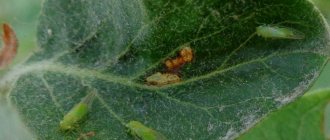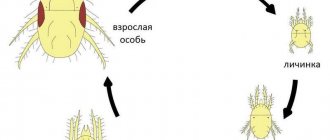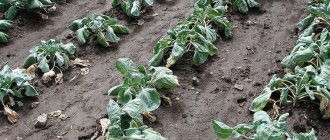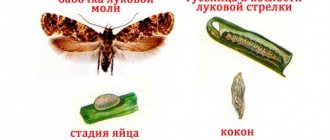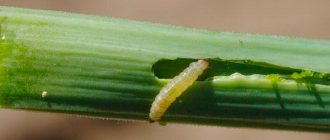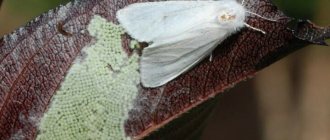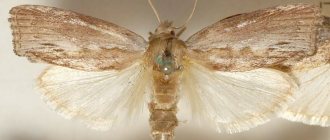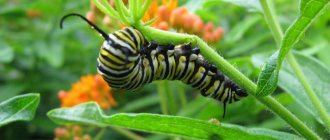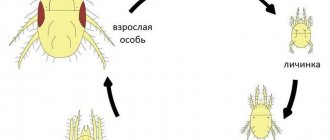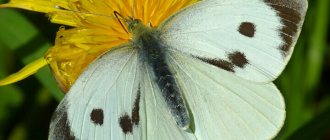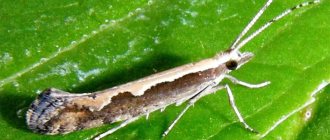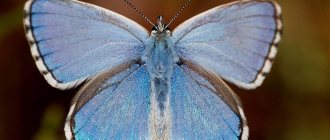Among the pests of fruit crops, the corrosive woody plant occupies not the last place. This is an insidious parasite that gnaws holes in the wood, thereby disrupting the sap flow of the plantings. As a result, the affected areas of the tree become so fragile that even a slight breeze can break them off.
The woodworm settles not only on fruit plants - it can be found both in the forest and in decorative plantings. If it is not stopped in time, it can not only cause significant damage to the crop, but also destroy the plants.
Description and photo of corrosive woodweed
The habitat of the tree tree is very extensive. The insect inhabits deciduous forests of southern and central Europe, Ukraine, the Far East, the Caucasus, Asia, and the Mediterranean.
Appearance
In the photo below, the corrosive tree is the cutest creature. This is a butterfly of a noticeable black and white color with a wingspan of up to 50 mm. Males are smaller in size than females.
What does an adult insect look like:
- white head with contrasting black forehead;
- milky white chest covered with black spots;
- the front wings are white in color with a pattern of angular blue-black spots;
- hind wings, with the exception of the anal region, translucent;
- the black abdomen is segmented and densely covered with light scales;
- in females the antennae are thread-like, dotted with sparse down to the middle, in males they are broadly feathered from the base, and serrated towards the end;
- sexual dimorphism is pronounced: the female has a long telescopic ovipositor, while the male has well-developed genitals separated by a membrane bridge.
On a note! A characteristic feature that distinguishes the corrosive woodworm from other butterflies is its white back with three pairs of rounded dark spots arranged in parallel, as well as the narrow shape of the wings, strongly tapering towards the outer edge.
The eggs are no different. The color is milky, yellow flowers, oblong oval shape, capsule length 1-1.2 mm.
Woodworm larvae are fleshy, thick caterpillars of white, cream, or pinkish hue. They grow up to 6 cm in length, with a body diameter of 7 mm. There are 6 eyes on each side of the slightly flattened head. The body is divided into segments, each of which is marked with 10-12 dark plaques covered with hairs. Due to the fact that the soles of the abdominal legs are equipped with tenacious hooks, the caterpillars are able to stay on any surface.
Brown pupae are cylindrical in shape, length varies from 2.5 to 3 cm, with a horn-like process located between the eyes.
Cherry slimy sawfly
Damages cherries, sweet cherries, and rarely apple, plum, and pear trees.
An adult sawfly reaches a length of 4-6 mm. Body black, shiny. The larvae are up to 11 mm long, greenish-yellow, covered with black mucus, and have 10 pairs of legs. The anterior end of the larva is thickened, the posterior end is narrowed. General viewA species is an evolutionarily formed set of individuals characterized by a single ... it resembles a comma.
Develops in two generations per year. The larvae overwinter in the soil at a depth of 2-5 cm. In the spring, the larvae pupate, and adult sawflies emerge in late May - early June. Females lay eggs in the leaf tissue on the underside. On the upper side of the leaf, the egg-laying sites are noticeable, resembling brown tubercles. The larvae scrape off the pulp of the leaf from the upper side, leaving the lower skin of the leaf and the network of veins intact. Having finished feeding, the larvae go into the soil and pupate.
Second generation sawflies fly at the end of July. After the cherry harvest, larvae hatch, causing serious damage. The leaves skeletonized by the larvae turn brown and dry out.
Control measures. It is extremely important to dig up the soil under the crowns in spring or autumn in order to destroy wintering larvae, and loosen the soil in July to destroy the larvae and pupae of the first generation sawfly.
It is also recommended to spray trees with karbofos, baxin or lepidocide after harvesting fruits and cherries, when there is a massive hatching of second-generation sawfly larvae.
Nuances of life activity of woodworts
Depending on climatic conditions, the flights of tree butterflies can be observed from the first and second ten days of June until the beginning of August. Peak flight activity occurs in mid-July.
Interesting! Adult woodies that emerge from pupae do not require nutrition and subsist on the nutrients they accumulated in the larval stage.
Females are not particularly mobile and often do not leave the tree on which they emerged from the pupa. Males are more active and flutter in the treetops in search of a female. After fertilization, the corrosive wood butterfly begins laying eggs. She does not burden herself with single laying and places eggs in crevices of bark or dried wood, 50-200 eggs at a time, feeling the places for laying with her ovipositor. Sometimes the oviposition is simply on the ground. The female's fertility is estimated at 2000 eggs. Having completed their purpose, the adults die off.
Embryos develop in one to two weeks. The hatching of caterpillars occurs simultaneously. The newly born generation crawls up the tree and is attached with the help of a thin web.
Interesting! The slightest breath of wind tears the larvae from the branches and transfers them to another plant object. In strong windy weather, mass death of caterpillars is observed. Thus, natural factors influence the distribution and regulation of the population of corrosive woodies.
Having settled in the crown of a tree, the young larva bites into annual shoots, leaf petioles and makes longitudinal tunnels, which leads to rapid withering of the affected plant. In these food sources, the larva continues to develop until the end of August. Having grown stronger, it moves to the lower parts of the shoots or perennial branches, which are now too tough for it.
Feeding continues until the onset of cold weather and usually stops at the end of October, beginning of November. After wintering, when the ambient temperature reaches 10-12°C, they resume feeding.
They become adults after 2 favorable winterings and 7 molts. For pupation, developed larvae crawl closer to the treetops, form a cocoon from wood waste and stay in it for 2 to 3 months.
Protection from natural enemies
Tiger moth larvae lack stinging spines and do not bite. However, the stiff bristles are an effective defense against many predators. When threatened, the larvae curl up tightly to protect their vulnerable areas. When they are tucked in, their hard spines are bent back; during capture, they push the caterpillar forward, preventing predators from capturing. This makes it almost impossible to force them to open when they are in a defensive position.
The spots on the forewings of adult woodworm moths are camouflage colors, making them less noticeable to predators. When threatened, adults "feign death" and roll over onto their stomachs to show off their brightly colored coats. They also secrete a drop of yellow acrid liquid from their mammary glands, which tastes very bitter.
The harmfulness of corrosive trees
Wood corrosive affects many species of deciduous and fruit trees. The damage is caused by the larvae, which damage young shoots and make tunnels in the trunks. Infected branches dry out prematurely and break off, which in turn leads to a decrease in yield.
Deciduous wood loses its value after being infected with corrosive woodworm. Numerous populations can provoke the complete death of a tree.
You can determine that woody wood has appeared on plants by the following signs:
- red dots at the base of the trunk - pest excrement;
- drying tops of young shoots;
- on the branches you can find a passage that is covered with a cobweb or the shell of a pupa; if you insert a wire into it, it will go deeper.
Plum papilion
Damages plums, cherry plums, sloe, and sometimes apricots, cherries, and sour cherries.
An adult insect is 4-6 mm long, with four delicate transparent wings. The body is black, the eyes are reddish. The larva is white, legless.
Develops in one generation per year. The larva overwinters in the pit of a damaged fruit. In the spring, one part of the larvae pupates, the other remains for a second winter. An adult insect gnaws a hole in the bone and climbs out through it. The emergence of the thick stalk begins at the end of plum blossoming, and 6-7 days after flowering a massive flight is observed.
Three weeks after the plum blossoms, the fat stalk ends.
Females lay eggs one at a time in the unhardened fruit pit. The larva eats away the kernel. Damaged fruits fall off unripe. The larvae remain in the pits of damaged fruits for the winter.
Control measures. Collection and destruction of fallen fruits. Digging the soil in the fall. It is possible to spray plum trees on the 8-10th day after flowering with karbofos.
How to deal with a pest
Cool, damp weather leads to the development of pathogenic microbes and fungi on trees, which causes the death of a large number of caterpillars. However, gardeners do not have to rely on the mercy of nature, and they independently take measures to combat the corrosive woody tree.
Action plan for exterminating the arrogant pest:
- During the summer of butterflies, before flowering, trees are sprayed with organophosphorus insecticides from backpack sprayers. Solutions are prepared in accordance with the instructions. For this purpose, “Karbofos”, DDT dust, hexachloran dust, “Chlorophos”, “Phosfamide”, “Fozalon”, “Cidial” “Kinmiks” are used.
- In cases of mild infection and detection of single individuals, insecticidal solutions are used to treat the tree trunks using thin spray tips or using a pear.
- You can treat the entrances of woodworms with swabs soaked in insecticide or gasoline. They are left in the hole for several days, and after the insects die, the passages are covered with clay.
- A labor-intensive but safe process is the removal of tracks from bole tunnels using calcined wire. At the end of the procedure, the passage is sealed with garden varnish.
- Shoots and branches damaged by woody corrosive shoots must be systematically pruned and burned.
Wood corrosive is a dangerous pest that, when multiplied en masse, can destroy hectares of green space. However, if you regularly inspect trees and, if signs of woodworms are detected, immediately begin to fight them, the death of trees can be avoided.
cherry fly
Damages the fruits of cherries, sweet cherries, and sometimes apricots.
The adult fly is 3-5 mm long, black, with a yellow-orange thoracic shield. There are four transverse dark stripes on the transparent wings. The larvae are up to 6 mm long, white, worm-shaped, legless, tapering towards the anterior end.
One-year generation. The pupae overwinter in false cocoons in the soil under the crown of a tree at a depth of 3-5 cm. The fly season begins at the end of May, after the cherry blossoms, and ends in mid-June. When the cherry fruit turns red, egg laying begins. Females pierce the skin of the fruit with their ovipositor and lay one or two eggs under it. Later, females lay eggs on ripening and mature fruits. The larvae feed on the pulp of the fruit. Damaged fruits become soft, darken, depressions form on them, and they rot. The development of the larvae lasts 16-20 days, after which they emerge from the fruit, fall to the ground and pupate in it.
Early varieties of cherries are less damaged. When harvesting is delayed, fruit damage increases. Sometimes the larvae crawl out of already collected fruits.
Control measures. Autumn or spring digging of the soil under the crowns of cherries and cherries in order to destroy pupae. Timely harvesting and quick removal from the garden. Collection and destruction of carrion fruits. Spraying trees with karbofos at the beginning of flies' oviposition - 5-6 days after the sum of effective temperatures reaches 224 degrees. On late varieties of cherries and sweet cherries, spraying is repeated after 10-12 days.
Bacterial diseases
Bacterial shoot rot caused by the bacterium Pseudomonas syringae may occur. The disease affects shoots, leaves, flowers and buds.
The disease makes itself felt by the appearance of small wet spots on the roots, which then turn black and enlarge. Initially, the infection appears at the site of mechanical injury or damage.
The causative agent of the disease is carried by rain. It all starts with brown longitudinal elongated stripes, and ends with rotting and dying of the bark, as well as the drying out of individual branches.
Accompanied by the appearance of watery or oily translucent spots, which subsequently darken. Young shoots will bend and dry out due to the disease.
Among beautiful flowering shrubs, lilac is the most popular and widespread in Russia. Its species and varieties are actively used in domestic ornamental gardening, especially common lilac (Syringa vulgaris) and Hungarian lilac (Syringa josikaea), which are very unpretentious and hardy. In addition, they bloom at different times: first with. ordinary, then s. Hungarian Today, the collection of the Main Botanical Garden of the Russian Academy of Sciences is one of the largest in the world and includes over 200 species, hybrids and varieties of lilac.
Unfortunately, various pests and diseases significantly reduce the stability and decorative value of this shrub.
